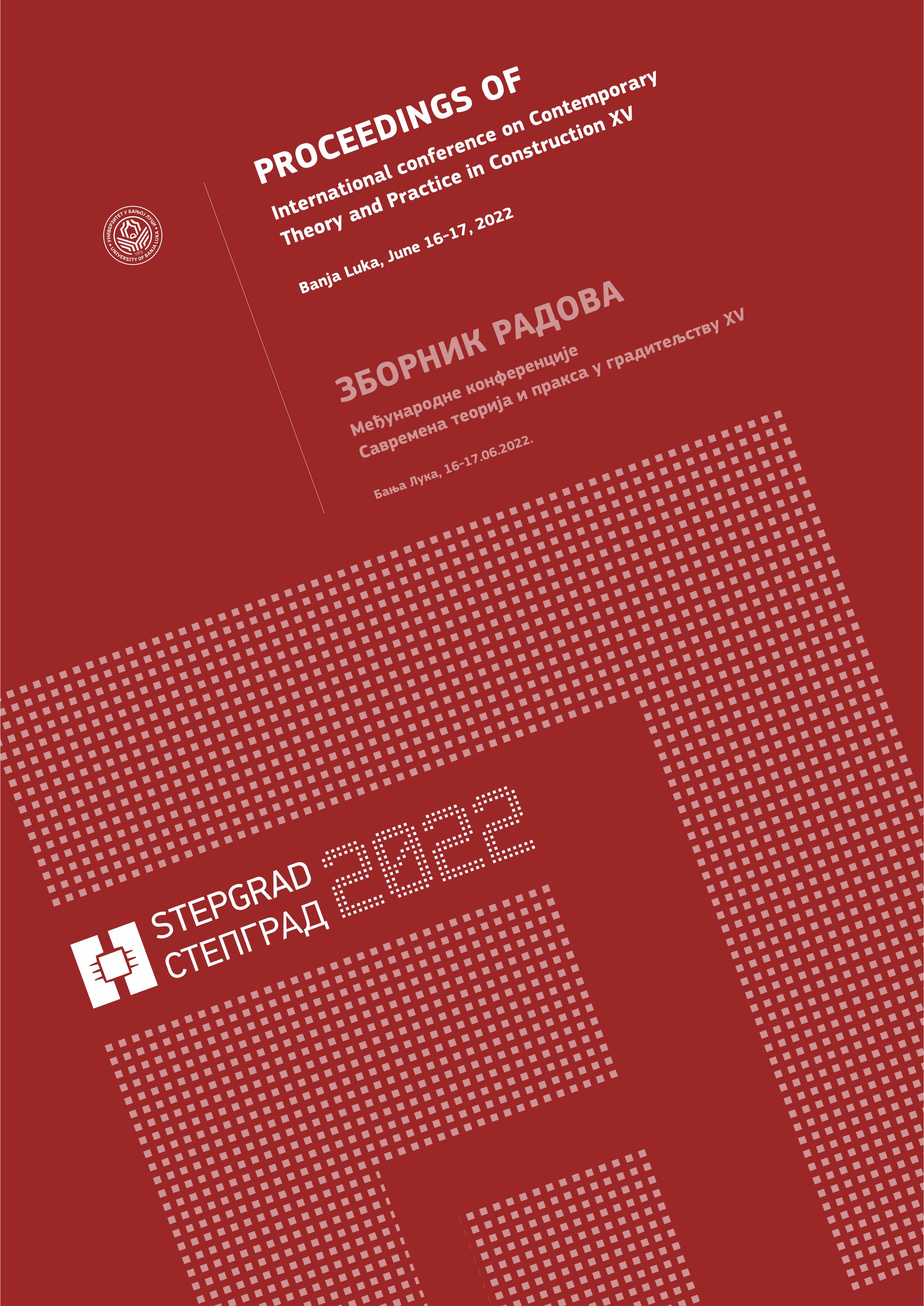MODEL OF POROUS MATERIALS BY RHEOLOGICAL-DYNAMICAL ANALOGY USING THE PRINCIPLES OF MASS AND ENERGY CONSERVATION
DOI:
https://doi.org/10.7251/STP2215092MAbstract
It is assumed that the porous material is based on the principle of conservation of mass and the principle of conservation of energy. The validity of both principles relies on experimental observations. Experimental results of different metals were used to compare the Poisson ratio as a function of porosity. A comparison is made between the theory of percolation and the model proposed in this paper based on the rheological-dynamic analogy (RDA). The results show that there is an excellent agreement between percolation theory and the RDA model. Finally, a new relationship between the creep coefficient and porosity was proved for all analyzed metals by defining their damage variable in the range of measurable porosities.
References
J. A. Choren, S. M. Heinrich, and M. B. Silver-Thorn, “Young’s modulus and volume porosity relationships for additive manufacturing applications,” Journal of Materials Science, vol. 48, no. 15. pp. 5103–5112, Aug. 2013, doi: 10.1007/s10853-013-7237-5.
R. M. Spriggs, “Expression for Effect of Porosity on Elastic Modulus of Polycrystalline Refractory Materials, Particularly Aluminum Oxide,” J. Am. Ceram. Soc., vol. 44, no. 12, pp. 628–629, Dec. 1961, doi: 10.1111/J.1151-2916.1961.TB11671.X.
E. Ryshkewitch, “Compression Strength of Porous Sintered Alumina and Zirconia,” J. Am. Ceram. Soc., vol. 36, no. 2, pp. 65–68, Feb. 1953, doi: 10.1111/J.1151-2916.1953.TB12837.X.
K. K. Phani and S. K. Niyogi, “Young’s modulus of porous brittle solids,” J. Mater. Sci. 1987 221, vol. 22, no. 1, pp. 257–263, Jan. 1987, doi: 10.1007/BF01160581.
J. C. Wang, “Young’s modulus of porous materials,” J. Mater. Sci., vol. 19, no. 3, pp. 801–808, Mar. 1984, doi: 10.1007/BF00540451.
J. Kováčik, “Correlation between Young’s modulus and porosity in porous materials,” J. Mater. Sci. Lett., vol. 18, no. 13, pp. 1007–1010, 1999, doi: 10.1023/A:1006669914946.
J. Kováčik, “Correlation between Poisson’s ratio and porosity in porous materials,” J. Mater. Sci., vol. 41, no. 4, pp. 1247–1249, Feb. 2006, doi: 10.1007/S10853-005-4237-0.
D. D. Milašinović, “Rheological-dynamical analogy: Prediction of damping parameters of hysteresis damper,” Int. J. Solids Struct., vol. 44, no. 22–23, pp. 7143–7166, Nov. 2007, doi: 10.1016/j.ijsolstr.2007.04.001.
D. D. Milašinović, “Rheological-dynamical analogy: Modeling of fatigue behavior,” Int. J. Solids Struct., vol. 40, no. 1, pp. 181–217, 2003, doi: 10.1016/S0020-7683(02)00518-8.
D. D. Milašinović, “Rheological–dynamical analogy: visco-elasto-plastic behavior of metallic bars,” Int. J. Solids Struct., vol. 41, no. 16–17, pp. 4599–4634, Aug. 2004, doi: 10.1016/j.ijsolstr.2004.02.061.
D. D. Milasinovic, “Rheological-dynamical continuum damage model for concrete under uniaxial compression and its experimental verification,” Theor. Appl. Mech., vol. 42, no. 2, pp. 73–110, 2015, doi: 10.2298/tam1502073m.
P. H. Mott and C. M. Roland, “Limits to Poisson’s ratio in isotropic materials,” Phys. Rev. B - Condens. Matter Mater. Phys., vol. 80, no. 13, p. 132104, Oct. 2009, doi: 10.1103/PhysRevB.80.132104.
D. Krajcinovic, D. Sumarac, and K. Mallick, “Elastic Parameters of Brittle, Elastic Solids Containing Slits —Critical State,” Int. J. Damage Mech., vol. 1, no. 4, pp. 386–403, 1992, doi: 10.1177/105678959200100402.
J. Lemaitre, “How to use damage mechanics,” Nucl. Eng. Des., vol. 80, no. 2, pp. 233–245, Jul. 1984, doi: 10.1016/0029-5493(84)90169-9.
J. Kováčik, “Correlation between shear modulus and porosity in porous materials,” J. Mater. Sci. Lett., vol. 20, no. 21, pp. 1953–1955, Nov. 2001, doi: 10.1023/A:1013186702962.
I. Balberg, “Universal percolation-threshold limits in the continuum,” Phys. Rev. B, vol. 31, no. 6, pp. 4053–4055, Mar. 1985, doi: 10.1103/PhysRevB.31.4053.
D. D. Milašinović, “Rheological-dynamical method for prediction of compressive strength and deformation of rocks,” Int. J. Rock Mech. Min. Sci., vol. 141, p. 104659, May 2021, doi: 10.1016/j.ijrmms.2021.104659.
J. P. Panakkal, H. Willems, and W. Arnold, “Nondestructive evaluation of elastic parameters of sintered iron powder compacts,” J. Mater. Sci., vol. 25, no. 2, pp. 1397–1402, Feb. 1990, doi: 10.1007/BF00585456.
V. A. Lubarda and D. Krajcinovic, “Damage tensors and the crack density distribution,” Int. J. Solids Struct., vol. 30, no. 20, pp. 2859–2877, Jan. 1993, doi: 10.1016/0020-7683(93)90158-4.
J. Dundurs and X. Markenscoff, “A Green’s Function Formulation of Anticracks and Their Interaction With Load-Induced Singularities,” J. Appl. Mech., vol. 56, no. 3, pp. 550–555, Sep. 1989, doi: 10.1115/1.3176126.
S. Spinner, F. P. Knudsen, and L. Stone, “Elastic constant- porosity relations for polycrystalline thoria,” J. Res. Natl. Bur. Stand. Sect.

